Utilizing Hydrophobic Sand to Construct an Air-Permeable Aquiclude to Enhance Rice Yield and Lodging Resistance
Abstract
1. Introduction
2. Materials and Methods
2.1. Study Area and Materials
2.2. Experiments and Methods
2.2.1. Experimental Setup
2.2.2. Rice Dissolved Oxygen Model
2.3. Sampling and Measurements
2.4. Data Processing and Analyzing
3. Results
3.1. The Oxygen-Increasing Effect of the Breathable and Anti-Seepage Plow Bottom on Rice
3.2. Lodging Resistance and Morphological Characteristics of the N3 Internode
3.2.1. Culm Morphology Parameters and Lodging-Related Traits of N3
3.2.2. The Anatomy Structure of the N3
3.3. Culm Morphology Parameters and Yield
4. Discussion
4.1. Effects of APAC on Rice Yield and Clum Morphology Characteristics
4.2. The APAC Is Beneficial to Enhance the Lodging Resistance of Rice
4.3. Economic Feasibility Analysis of APAC
5. Conclusions
Author Contributions
Funding
Data Availability Statement
Conflicts of Interest
References
- Meng, X.; Li, S.; Akhmadi, K.; He, P.; Dong, G. Trends, turning points, and driving forces of desertification in global arid land based on the segmental trend method and SHAP model. GIScience Remote Sens. 2024, 61, 2367806. [Google Scholar] [CrossRef]
- Ahmed, S.M. Impacts of drought, food security policy and climate change on performance of irrigation schemes in sub-saharan Africa: The case of Sudan. Agric. Water Manag. 2020, 232, 106064. [Google Scholar] [CrossRef]
- Li, Y.; Niu, W.; Wang, J.; Liu, L.; Zhang, M.; Xu, J. Effects of Artificial Soil Aeration Volume and Frequency on Soil En-zyme Activity and Microbial Abundance when Cultivating Greenhouse Tomato. Soil Sci. Soc. Am. J. 2016, 80, 1208. [Google Scholar] [CrossRef]
- Yoshinaga, S.; Takai, T.; Arai-Sanoh, Y.; Ishimaru, T.; Kondo, M. Varietal differences in sink production and grain-filling ability in recently developed high-yielding rice (Oryza sativa L.) varieties in Japan. Field Crops Res. 2013, 150, 74–82. [Google Scholar] [CrossRef]
- Setter, T.L.; Laureles, E.V.; Mazaredo, A.M. Lodging reduces yield of rice by self-shading and reductions in canopy photosynthesis. Field Crops Res. 1997, 49, 95–106. [Google Scholar] [CrossRef]
- Berry, P.M.; Spink, J. Predicting yield losses caused by lodging in wheat. Field Crops Res. 2012, 137, 19–26. [Google Scholar] [CrossRef]
- Niu, Y.; Chen, T.; Zhao, C.; Zhou, M. Lodging prevention in cereals: Morphological, biochemical, anatomical traits and their molecular mechanisms, management and breeding strategies. Field Crops Res. 2022, 289, 108733. [Google Scholar] [CrossRef]
- Zhang, S.; Yang, Y.; Zhai, W.; Tong, Z.; Shen, T.; Li, Y.C.; Zhang, M.; Sigua, G.C.; Chen, J.; Ding, F. Controlled-release nitrogen fertilizer improved lodging resistance and potassium and silicon uptake of direct-seeded rice. Crop Sci. 2019, 59, 2733–2740. [Google Scholar] [CrossRef]
- Zhang, W.; Wu, L.; Ding, Y.; Yao, X.; Wu, X.; Weng, F.; Li, G.; Liu, Z.; Tang, S.; Ding, C.; et al. Nitrogen fertilizer application affects lodging resistance by altering secondary cell wall synthesis in japonica rice (Oryza sativa). J. Plant Res. 2017, 130, 859–871. [Google Scholar] [CrossRef]
- Khush, G.S. Green revolution: Preparing for the 21st century. Genome 1999, 42, 646–655. [Google Scholar] [CrossRef]
- Aya, K.; Hobo, T.; Sato-Izawa, K.; Ueguchi-Tanaka, M.; Kitano, H.; Matsuoka, M. A novel AP2 -type transcription factor, Small Organ Size1, controls organ size downstream of an auxin signaling pathway. Plant Cell Physiol. 2014, 55, 897–912. [Google Scholar] [CrossRef] [PubMed]
- Yang, C.; Yang, L.; Yan, T.; Ouyang, Z. Effects of nutrient and water regimes on lodging resistance of rice. China J. Appl. Ecol. 2004, 15, 646–650. [Google Scholar] [CrossRef]
- Wang, C.; Blagodatskaya, E.; Dippold, M.A.; Dorodnikov, M. Keep oxygen in check: Contrasting effects of short-term aeration on hydrolytic versus oxidative enzymes in paddy soils. Soil Biol. Biochem. 2022, 169, 108690. [Google Scholar] [CrossRef]
- WaWang, C.; Dippold, M.A.; Blagodatskaya, E.; Dorodnikov, M. Oxygen matters: Short- and medium-term effects of aeration on hydrolytic enzymes in a paddy soil. Geoderma 2022, 407, 115548. [Google Scholar] [CrossRef]
- Xu, C.; Xiao, D.; Chen, S.; Chu, G.; Liu, Y.; Zhang, X.; Wang, D. Changes in the activities of key enzymes and the abundance of functional genes involved in nitrogen trans-formation in rice rhizosphere soil under different aerated conditions. J. Integr. Agric. 2023, 22, 923–934. [Google Scholar] [CrossRef]
- Qian, Z.; Zhuang, S.; Gao, J.; Tang, L.; Harindintwali, J.D.; Wang, F. Aeration increases soil bacterial diversity and nutrient transformation under mulching-induced hypoxic conditions. Sci. Total Environ. 2022, 817, 153017. [Google Scholar] [CrossRef]
- Zhou, W.; Yi, Y.; Tu, N.; Tan, Z.; Wang, H.; Yang, Y.; Wang, C.; Ti, Z. Research progresses in the effects of rhizosphere oxygen-increasing on rice root morphology and physiology. Chin. J. Eco-Agric. 2018, 26, 367–376. [Google Scholar] [CrossRef]
- Campos, A.C.; Etchevers, J.B.; Oleschko, K.L.; Hidalgo, C.M. Soil microbial biomass and nitrogen mineralization rates along an altitudinal gradient on the cofre de perote volcano (Mexico): The importance of landscape position and land use. Land Degrad. Dev. 2014, 25, 581–593. [Google Scholar] [CrossRef]
- Baram, S.; Evans, J.F.; Berezkin, A.; Ben-Hur, M. Irrigation with treated wastewater containing nanobubbles to aerate soils and reduce nitrous oxide emissions. J. Clean. Prod. 2021, 280, 124509. [Google Scholar] [CrossRef]
- Guber, A.K.; Smucker, A.J.M.; Berhanu, S.; Miller, J.M.L. Subsurface Water Retention Technology Improves Root Zone Water Storage for Corn Production on Coarse-Textured Soils. Vadose Zone J. 2015, 14, 1–13. [Google Scholar] [CrossRef]
- Nkurunziza, L.; Chirinda, N.; Lana, M.; Sommer, R.; Karanja, S.; Rao, I.; Romero Sanchez, M.A.; Quintero, M.; Kuyah, S.; Lewu, F.; et al. The Potential Benefits and Trade-Offs of Using Sub-surface Water Retention Technology on Coarse-Textured Soils: Impacts of Water and Nutrient Saving on Maize Production and Soil Carbon Sequestration. Front. Sustain. Food Syst. 2019, 3, 71. [Google Scholar] [CrossRef]
- Inner Mongolia Statistical Yearbook. 2021. Available online: http://tj.nmg.gov.cn/files_pub/content/PAGEPACK/83e5521da4e94d50ab45483b58e5fa7e/zk/indexch.htm (accessed on 22 July 2024).
- Lozano, Y.M.; Lehnert, T.; Linck, L.T.; Lehman, A.; Rillig, M.C. Microplastic Shape, Polymer Type, and Concentration Affect Soil Properties and Plant Biomass. Front. Plant Sci. 2021, 424, 127283. [Google Scholar] [CrossRef] [PubMed]
- Shi, R.; Liu, W.; Lian, Y.; Wang, Q.; Zeb, A.; Tang, J. Phytotoxicity of polystyrene, polyethylene and polypropylene microplastics on tomato (Lycopersicon esculentum L.). J. Environ. Manag. 2022, 317, 115441. [Google Scholar] [CrossRef]
- Lin, H.; Cui, G.; Jin, Q.; Liu, J.; Dong, Y. Effects of microplastics on the uptake and accumulation of heavy metals in plants: A review. J. Environ. Chem. Eng. 2024, 12, 111812. [Google Scholar] [CrossRef]
- Ismail, S.M.; Ozawa, K. Improvement of crop yield, soil moisture distribution and water use efficiency in sandy soils by clay application. Appl. Clay Sci. 2007, 37, 81–89. [Google Scholar] [CrossRef]
- Ray, S.S.; Soni, R.; Kim, I.-C.; Park, Y.I.; Lee, C.Y.; Kwon, Y.N. Surface innovation for fabrication of superhydrophobic sand grains with improved water holding capacity for various environmental applications. Environ. Technol. Innov. 2022, 28, 102849. [Google Scholar] [CrossRef]
- Chen, L.; Si, Y.; Guo, Z.; Liu, W. Superhydrophobic sand: A hope for desert water storage and transportation projects. J. Mater. Chem. A 2017, 5, 6416–6423. [Google Scholar] [CrossRef]
- Atta, A.M.; Abdullah, M.M.S.; Al-Lohedan, H.A.; Mohamed, N.H. Coating Sand with New Hydrophobic and Superhydrophobic Silica/Paraffin Wax Nanocapsules for Desert Water Storage and Transportation. Coatings 2019, 9, 124. [Google Scholar] [CrossRef]
- González-Peñaloza, F.A.; Zavala, L.M.; Jordán, A.; Bellinfante, N.; Bárcenas-Moreno, G.; Mataix-Solera, J.; Granged, A.J.P.; Granja-Martins, F.M.; Neto-Paixão, H.M. Water repellency as conditioned by particle size and drying in hydrophobized sand. Geoderma 2013, 209, 31–40. [Google Scholar] [CrossRef]
- Sun, X.; Liu, Y.; Mopidevi, S.; Meng, Y.; Huang, F.; Parisi, J.; Nieh, M.-P.; Cornelius, C.; Suib, S.L.; Lei, Y. Super-hydrophobic “smart” sand for buried explosive detection. Sens. Actuators B Chem. 2014, 195, 52–57. [Google Scholar] [CrossRef]
- Mitzel, M.R.; Sand, S.; Whalen, J.K.; Tufenkji, N. Hydrophobicity of biofilm coatings influences the transport dynamics of polystyrene nanoparticles in biofilm-coated sand. Water Res. 2016, 92, 113–120. [Google Scholar] [CrossRef] [PubMed]
- Tschapek, M.; Wasowksi, C.; Falasca, S. Character and change in the hydrophilic properties of quartz sand. Z. Pflanzenernährung Bodenkd. 1983, 146, 295–301. [Google Scholar] [CrossRef]
- Barthlott, W.; Neinhuis, C. Purity of the sacred lotus, or escape from contamination in biological surfaces. Planta 1997, 202, 1–8. [Google Scholar] [CrossRef]
- Zhou, Z.; Leung, A.K. Modifying the mechanical properties of sand by using different hydrophobic conditions. Acta Geotech. 2022, 17, 3783–3797. [Google Scholar] [CrossRef]
- Salem, M.A.; Al-Zayadneh, W.; Schulze, H.F.; Cheruth, A. Effect of nano-hydrophobic sand layer on Bermudagrass (Cynodon spp.) in urban landscaping. Urban Water J. 2014, 11, 167–173. [Google Scholar] [CrossRef]
- Salem, M.A.; Al-Zayadneh, W.; Cheruth, A.J. Water Conservation and Management with Hydro-phobic Encapsulation of Sand. Water Resour. Manag. 2010, 24, 2237–2246. [Google Scholar] [CrossRef]
- Myrzabaeva, M.; Insepov, Z.; Boguspaev, K.K.; Faleev, D.G.; Nazhipkyzy, M.; Lesbayev, B.T.; Mansurov, Z.A. Investigation of Nanohydrophobic Sand as an Insulating Layer for Cultivation of Plants in Soils Contaminated with Heavy Metals. Eurasian Chem.-Technol. J. 2017, 19, 91–98. [Google Scholar] [CrossRef]
- Qin, S. Hydrophobic Particle, Its Preparation Method, Air-Preamble and Hydrophobicity Structure and Its Formation Method. CN Patent CN101838116A, 11 February 2015. [Google Scholar]
- Elad, L.; Maria, I.D.; Noam, W. Impact of wind speed and soil permeability on aeration time in the upper vadose zone. Agric. For. Meteorol. 2019, 269–270, 294–304. [Google Scholar] [CrossRef]
- Meng, Q.; Qin, S.; Yu, F.; Liu, J.; Li, Y.; Liu, C.; Ren, G. Effects of Different Anti-seepage Treatments on Root Growth of Rice. J. Anhui Agric. Sci. 2018, 46, 179–181. [Google Scholar] [CrossRef]
- Hu, P.; Yang, Q.; Yang, Z.; Han, K.; Pan, J. Experimental study on dissolved oxygen content in water and its physical influence factors. J. Hydraul. Eng. 2019, 50, 679–686. [Google Scholar] [CrossRef]
- Morten, L.; Jakob, S.; Eva, O.; Walter, W.W.; Ronnie, G. O2 dynamics in the rhizosphere of young rice plants (Oryza sativa L.) as studied by planar optodes. Plant Soil 2015, 390, 279–292. [Google Scholar] [CrossRef]
- Zhu, L.; Yu, S.; Jin, Q. Effects of Aerated Irrigation on Leaf Senescence at Late Growth Stage and Grain Yield of Rice. Rice Sci. 2012, 19, 44–48. [Google Scholar] [CrossRef]
- Islam, M.S.; Peng, S.B.; Visperas, R.M.; Ereful, N.; Bhuiya, M.S.U.; Julfiquar, A.W. Lodging-related morphological traits of hybrid rice in a tropical irrigated ecosystem. Field Crops Res. 2007, 101, 240–248. [Google Scholar] [CrossRef]
- Zhang, J.; Li, G.; Song, Y.; Liu, Z.; Yang, C.; Tang, S.; Zheng, C.; Wang, S.; Ding, Y. Lodging resistance characteristics of high-yielding rice populations. Field Crops Res. 2014, 161, 64–74. [Google Scholar] [CrossRef]
- Gao, H.; Dou, Z.; Chen, L.; Lu, Y.; Sun, D.; Xu, Q.; Sun, R.; Chen, X. Effects of semi-deep water irrigation on hybrid indica rice lodging resistance. Front. Plant Sci. 2022, 13, 1038129. [Google Scholar] [CrossRef]
- Han, L.; Zhou, R.; Zhou, T.; Lin, C.; Gan, Q.; Ni, D.; Shi, Y.; Song, F. Correlation analysis and QTLs mapping of lodging resistance and yield traits in rice. J. Biol. 2023, 40, 65–70. [Google Scholar] [CrossRef]
- Wang, X.; Xu, L.; Li, X.; Yang, G.; Wang, F.; Peng, S. Grain yield and lodging-related traits of ultrashort-duration varieties for direct-seeded and double-season rice in Central China. J. Integr. Agric. 2022, 21, 2888–2899. [Google Scholar] [CrossRef]
- Xing, Y.; Wang, J.Y.; Yang, J.Z.; Chen, D.; Du, X.; Guo, J.; Song, L. Distribution and existing problems of mining land for abandoned open-pit mines in China. Remote Sens. Nat. Resour. 2024, 36, 21–26. Available online: https://link.cnki.net/urlid/10.1759.P.20231109.1011.004 (accessed on 10 November 2023).
- Khalid, S.; Shahid, M.; Niazi, N.K.; Murtaza, B.; Bibi, I.; Dumat, C. A comparison of technologies for remediation of heavy metal contaminated soils. J. Geochem. Explor. 2017, 182, 247–268. [Google Scholar] [CrossRef]
- Yu, H.; Zahidi, I.; Liang, D. Mine land reclamation, mine land reuse, and vegetation cover change: An intriguing case study in Dartford, the United Kingdom. Environ. Res. 2023, 225, 115613. [Google Scholar] [CrossRef]
- Lorimer, J.; Sandom, C.; Jepson, P.; Doughty, C.; Barua, M.; Kirby, K.J. Rewilding: Science, Practice, and Politics. Annu. Rev. Environ. Resour. 2015, 40, 39–62. [Google Scholar] [CrossRef]
- Yong, L. The Transformation of Guangyang Island in Chongqing. Sci. Technol. Dly. 2023, 8, 1–2. [Google Scholar] [CrossRef]
- Zhang, E. Promoting the realization of the value of ecological products by means of ecological restoration—Qualitative comparative analysis of fuzzy sets based on multiple cases. Prices Mon. 2024, 8, 1–11. Available online: https://link.cnki.net/urlid/36.1006.f.20240614.1126.002 (accessed on 1 March 2024).
- Zhang, L.; Zhou, Y. Research on the path and mechanism improment of ecological product value realization. Acta Ecol. Sin. 2021, 41, 7893–7899. [Google Scholar] [CrossRef]

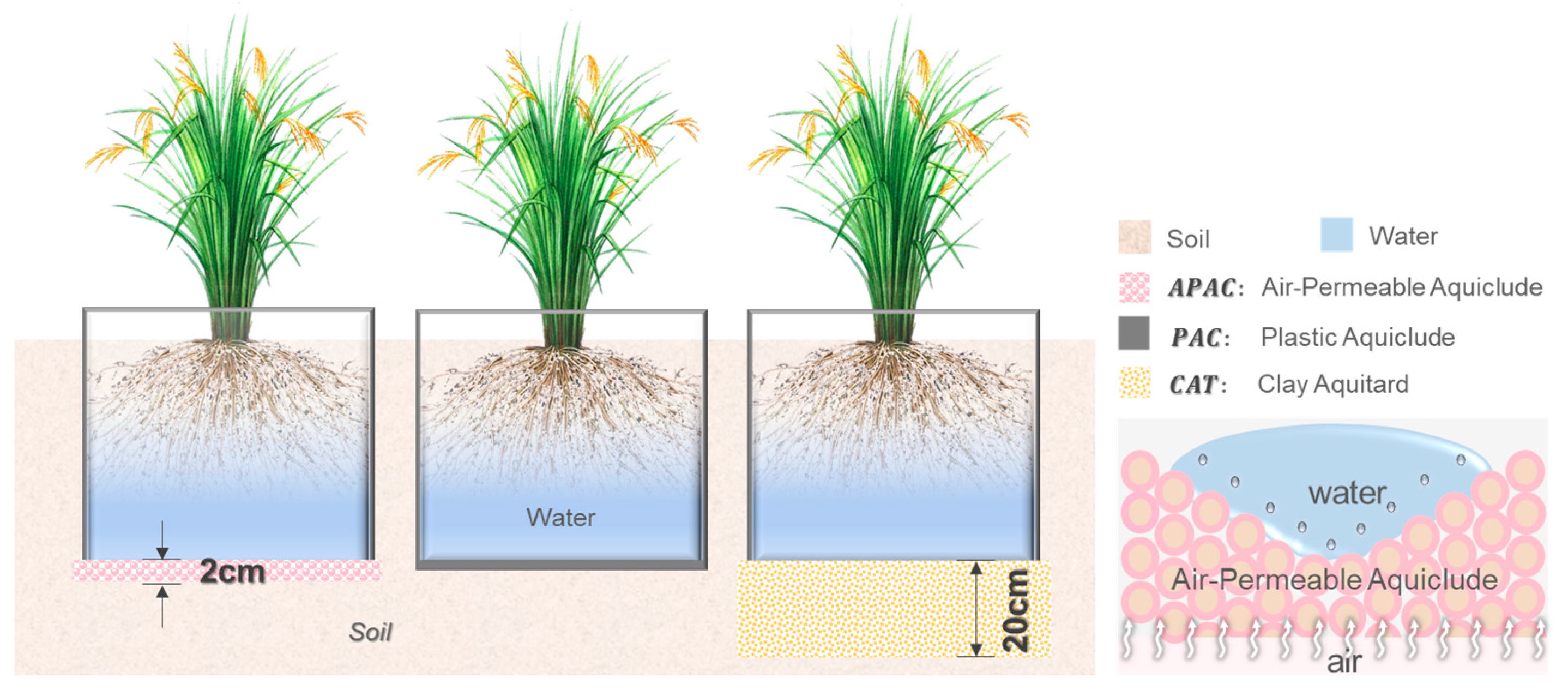
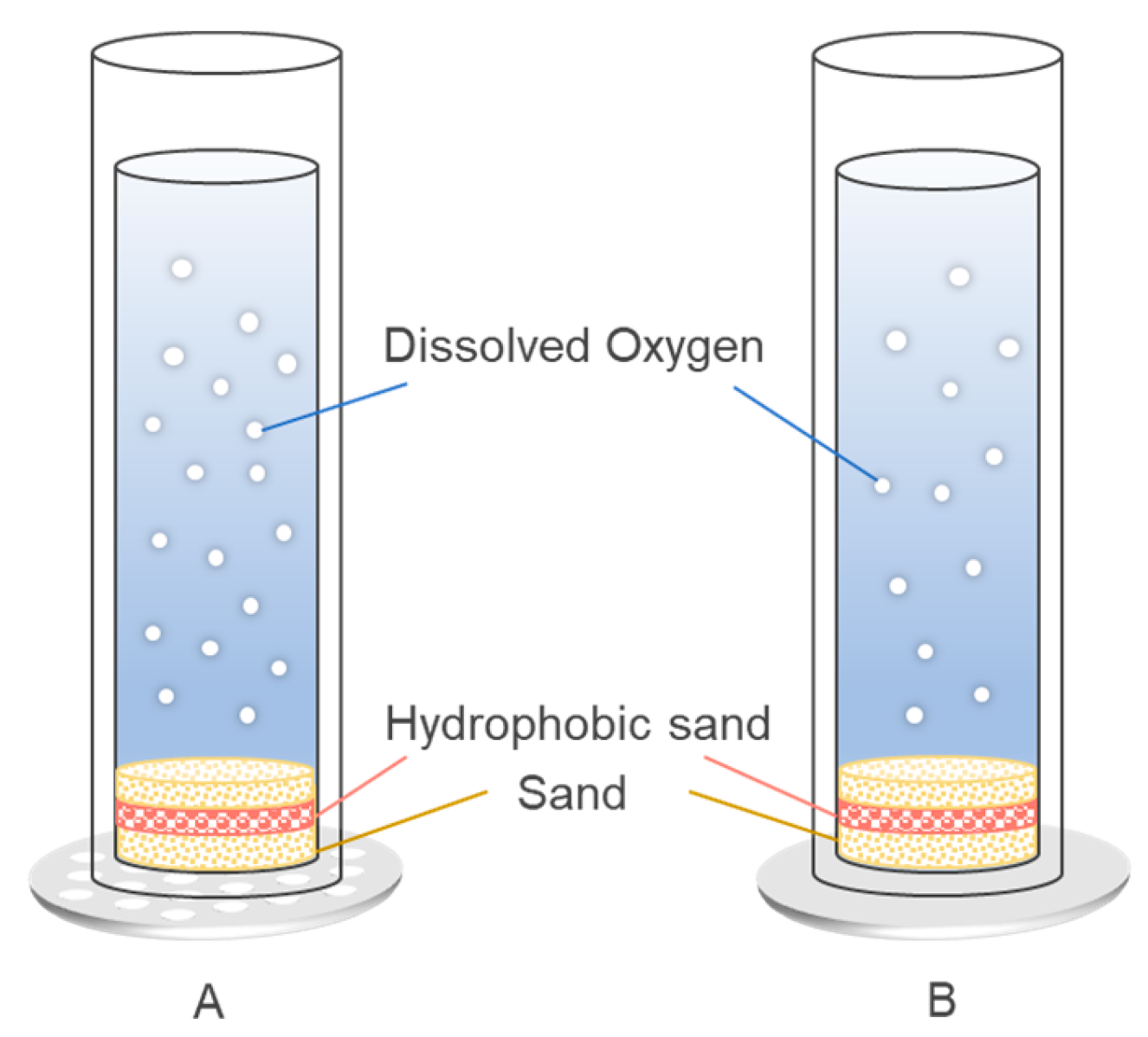
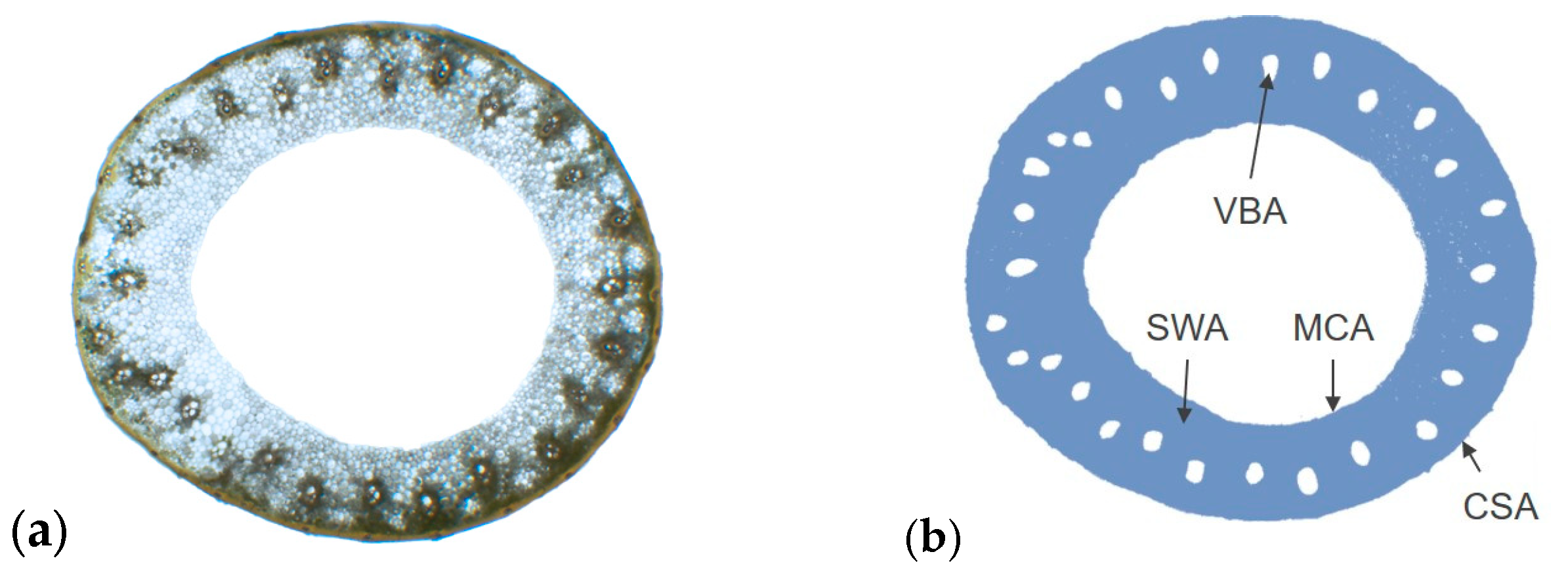

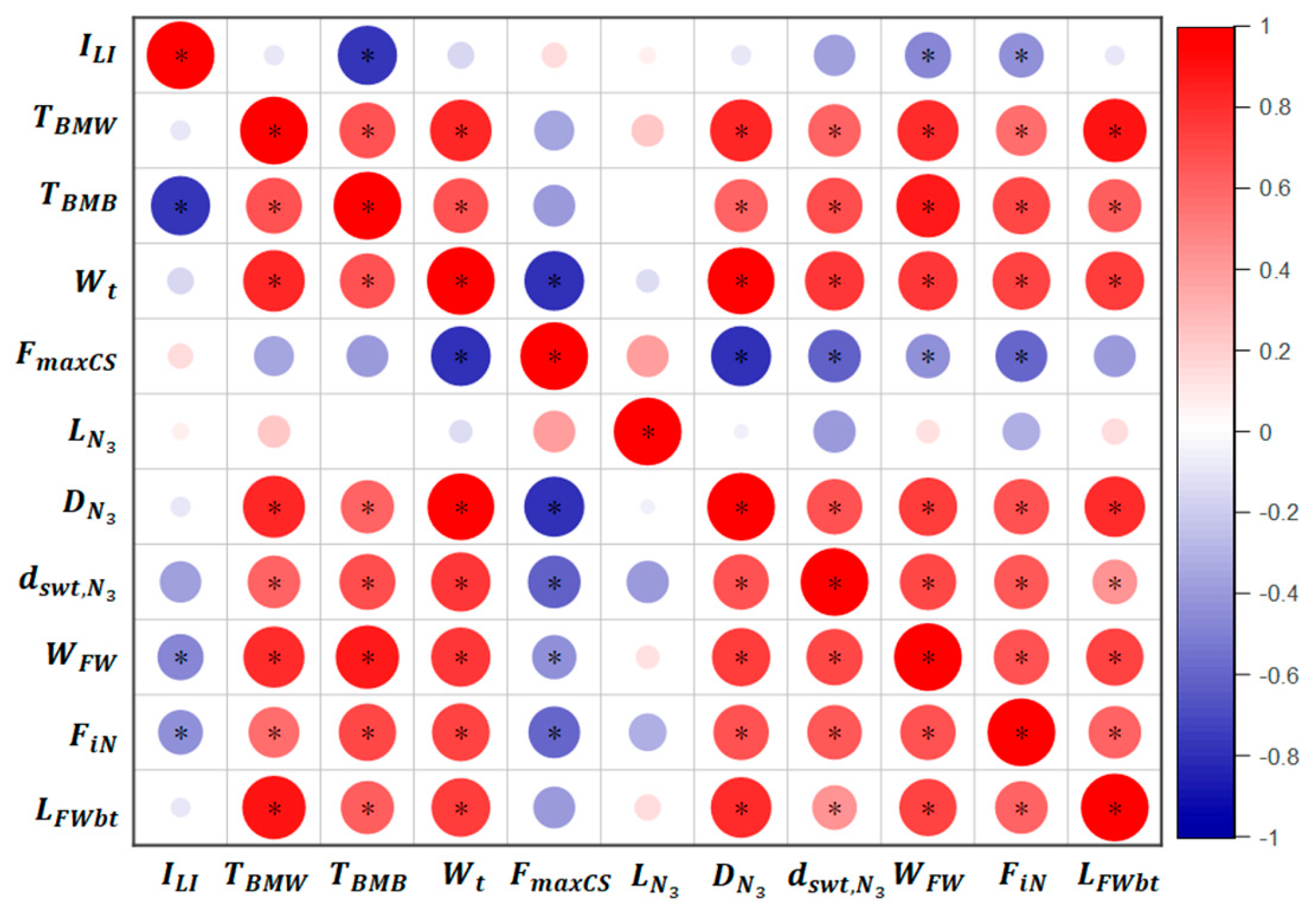

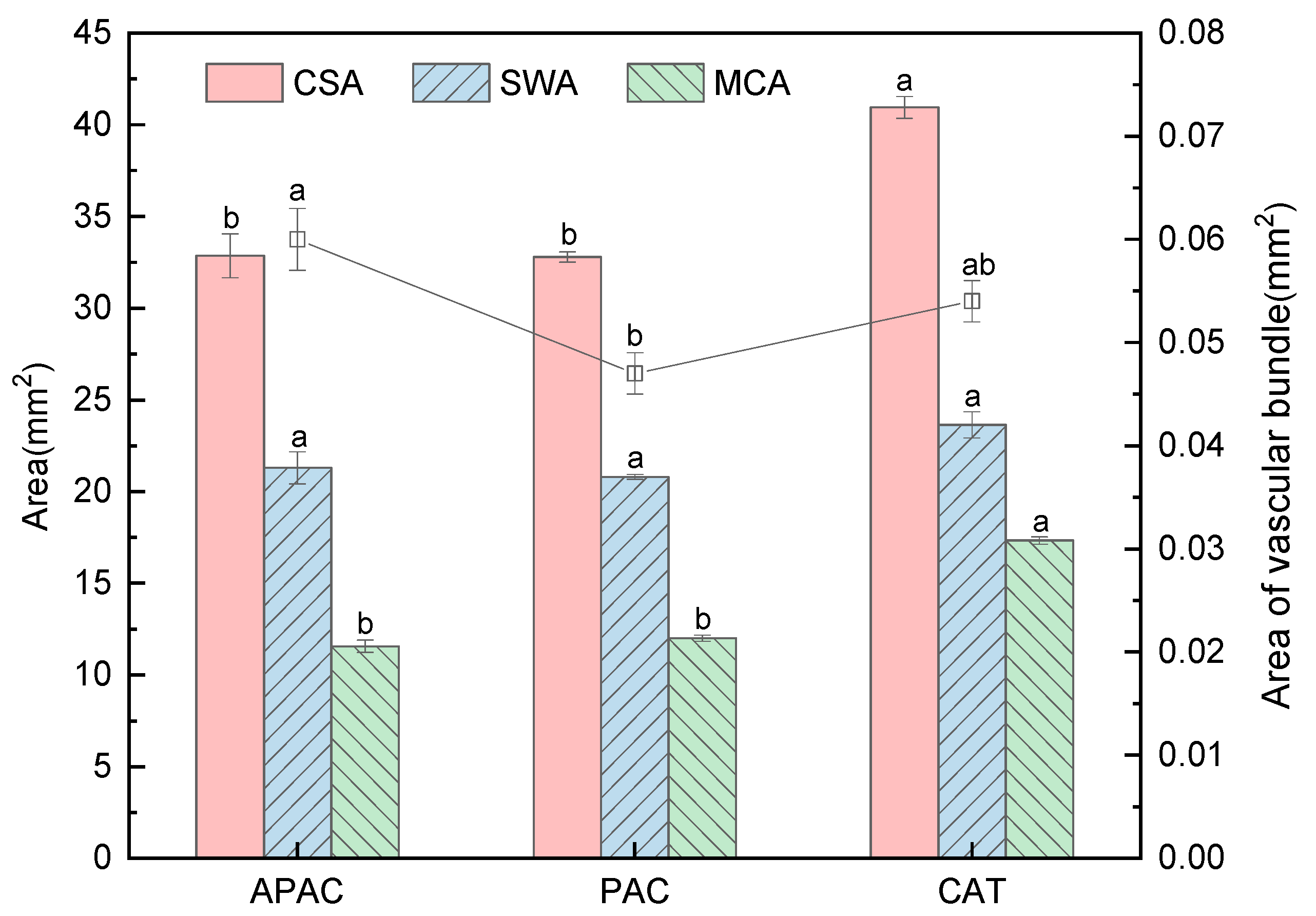
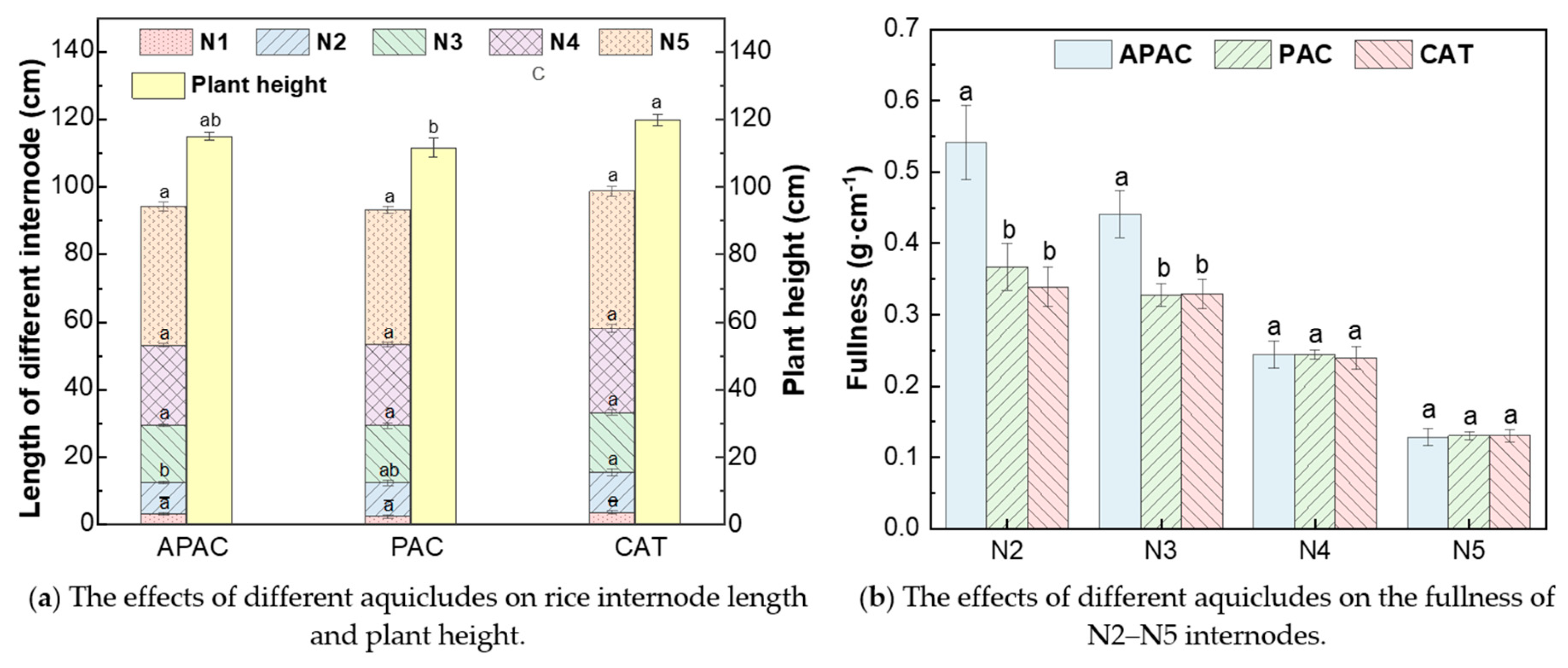
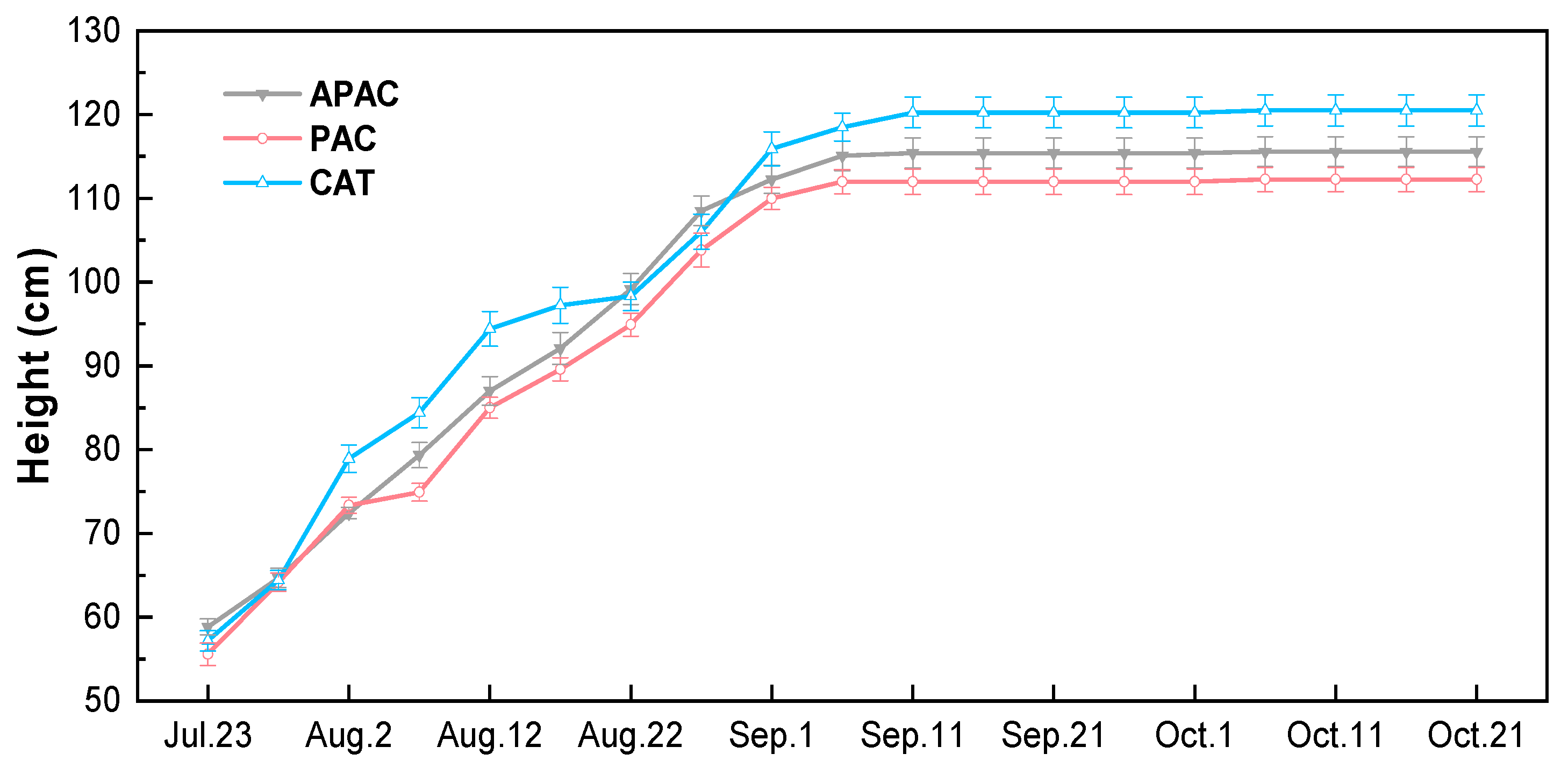
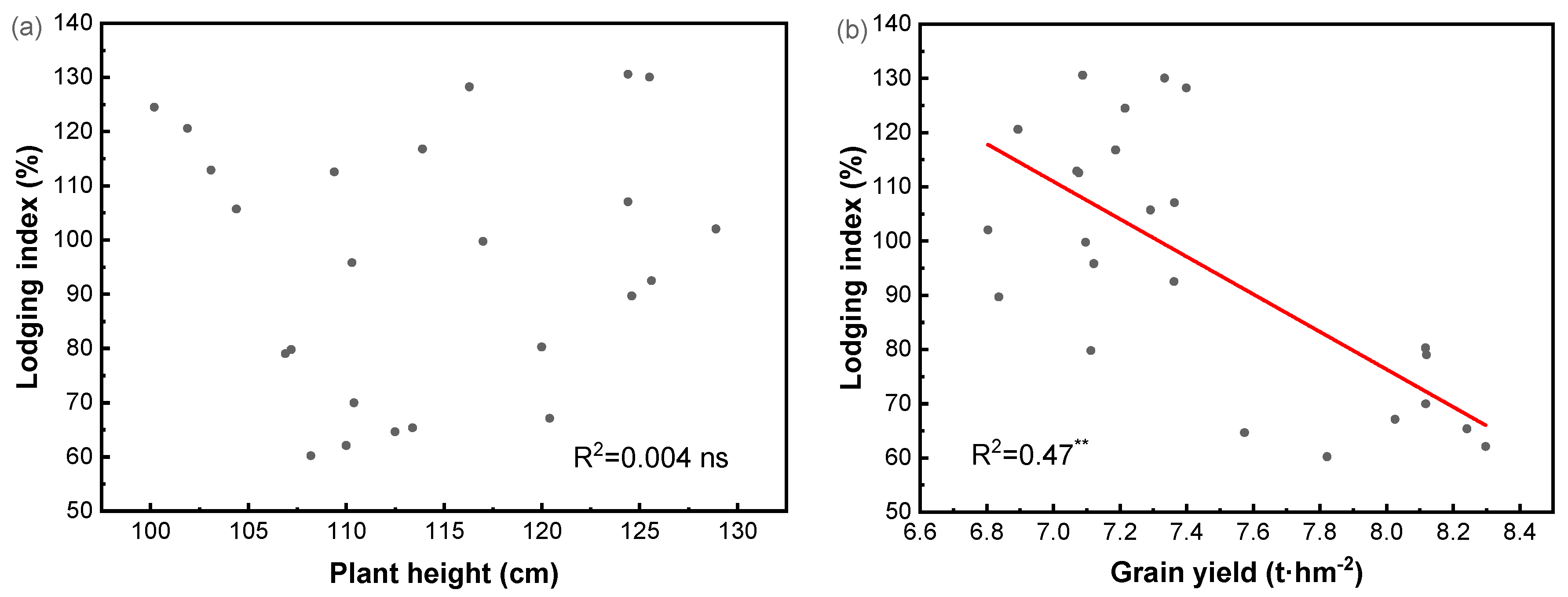
| Category | Thickness (cm) | Air Permeability (L·m−2·s−1) | Leakage (mm·d−1) |
|---|---|---|---|
| Sandy soil | 20 | 10.65 | 5760 |
| APAC | 2 | 6.08 | 0 |
| PAC | - | 0 | 0 |
| CAT | 20 | 1.58 | 5 |
| Control Index | R-S 1 | PTT-S 2 | LT-S 3 | JB-S 4 | F-S 5 | M-S 6 |
|---|---|---|---|---|---|---|
| Upper limit of rain storage (mm) | 50 | 60 | D&S-F 7 | 80 | 80 | D-C 8 |
| Upper limit of irrigation (mm) | 40 | 15 | D&S-F | 30 | 15 | D-C |
| Lower limit of rain storage (mm) | 0 | 0 | D&S-F | 0 | 0 | D-C |
| 1 (cm) | 2 (mm) | 3 (mm) | 4 (g) | (g·cm−1) | 5 (g) | 6 (cm) | |
|---|---|---|---|---|---|---|---|
| APAC | 16.96 ± 0.44 a | 4.774 ± 0.217 a | 1.014 ± 0.060 a | 1.8979 ± 0.1502 a | 0.440 ± 0.033 a | 8.822 ± 0.473 a | 102.58 ± 1.94 a |
| PAC | 17.03 ± 0.85 a | 4.517 ± 0.129 ab | 0.858 ± 0.029 b | 1.3673 ± 0.0688 b | 0.326 ± 0.016 b | 7.527 ± 0.322 b | 101.99 ± 2.71 a |
| CAT | 17.71 ± 0.73 a | 4.181 ± 0.207 b | 0.857 ± 0.032 b | 1.3797 ± 0.0785 b | 0.328 ± 0.021 b | 7.333 ± 0.484 b | 104.49 ± 3.26 a |
| ANOVA | |||||||
| ns 7 | ns | * | ** | ** | * | ns | |
| Model | (N·cm) | (N·cm) | (%) | Wt (mm3) | (N·mm−2) |
|---|---|---|---|---|---|
| APAC | 13.03 ± 0.83 a | 8.92 ± 0.62 a | 68.6 ± 2.63 b | 10.05 ± 1.32 a | 9.52 ± 0.78 b |
| PAC | 6.98 ± 0.41 b | 7.57 ± 0.51 a | 109.83 ± 6.66 a | 7.79 ± 0.64 ab | 9.96 ± 0.74 ab |
| CAT | 7.01 ± 0.65 b | 7.60 ± 0.71 a | 108.76 ± 4.37 a | 6.60 ± 0.97 b | 12.12 ± 0.79 a |
| ANOVA | |||||
| ** | ns 1 | ** | ns | ns | |
| APAC | PAC | CAT | ANOVA | |
|---|---|---|---|---|
| Grain yield () | 8.09 ± 0.26 b | 7.22 ± 0.17 a | 7.06 ± 0.16 a | * |
Disclaimer/Publisher’s Note: The statements, opinions and data contained in all publications are solely those of the individual author(s) and contributor(s) and not of MDPI and/or the editor(s). MDPI and/or the editor(s) disclaim responsibility for any injury to people or property resulting from any ideas, methods, instructions or products referred to in the content. |
© 2024 by the authors. Licensee MDPI, Basel, Switzerland. This article is an open access article distributed under the terms and conditions of the Creative Commons Attribution (CC BY) license (https://creativecommons.org/licenses/by/4.0/).
Share and Cite
Ma, X.; Wu, J.; Su, Y.; Qin, S.; Pilla, F. Utilizing Hydrophobic Sand to Construct an Air-Permeable Aquiclude to Enhance Rice Yield and Lodging Resistance. Agronomy 2024, 14, 2085. https://doi.org/10.3390/agronomy14092085
Ma X, Wu J, Su Y, Qin S, Pilla F. Utilizing Hydrophobic Sand to Construct an Air-Permeable Aquiclude to Enhance Rice Yield and Lodging Resistance. Agronomy. 2024; 14(9):2085. https://doi.org/10.3390/agronomy14092085
Chicago/Turabian StyleMa, Xiaoyan, Jing Wu, Yuming Su, Shengyi Qin, and Francesco Pilla. 2024. "Utilizing Hydrophobic Sand to Construct an Air-Permeable Aquiclude to Enhance Rice Yield and Lodging Resistance" Agronomy 14, no. 9: 2085. https://doi.org/10.3390/agronomy14092085
APA StyleMa, X., Wu, J., Su, Y., Qin, S., & Pilla, F. (2024). Utilizing Hydrophobic Sand to Construct an Air-Permeable Aquiclude to Enhance Rice Yield and Lodging Resistance. Agronomy, 14(9), 2085. https://doi.org/10.3390/agronomy14092085







